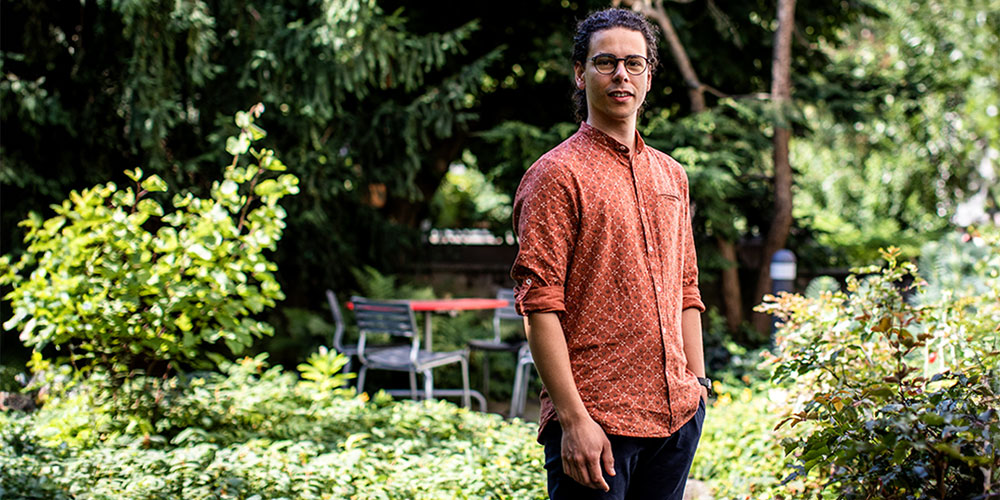In Focus: Sofian Bouaouina looks for communication patterns in the kitchen
While most people find grammar a yawn, Sofian Bouaouina found it a source of fascination. This led him from the village of Diegten to the University of Basel, where he initially studied to be a secondary school teacher in French and history, before developing a taste for linguistics.
14 August 2024 | Céline Emch
From his very first lecture in French linguistics, Sofian Bouaouina’s understanding of language changed fundamentally. It was no longer a question of rigid grammatical norms, but of analyzing everyday language use. Multimodal conversation analysis provided a particular conceptual breakthrough. This approach showed him that communication goes beyond spoken language and includes body movements, gaze, objects within space, and much more. “I was blown away,” says Bouaouina, now a postdoc and lecturer in French linguistics.
The recipe for interaction
Conversation analysis long focused primarily on the senses of sight and hearing. Within the theoretical framework of conversation analysis, an SNSF project headed by linguistics professor Lorenza Mondada was the first to empirically investigate the extent to which participants to conversation use the senses of touch, taste and smell – previously neglected by conversation analytic research – in and for interactions around food and communicate them to each other.
The five-year project shows that a taste experience isn’t necessarily a private, individual sensory event, but that it can also be made comprehensible to others. “Of course, I ‘taste’ cheese when I eat it, for example. But this isn’t something I necessarily display to my co-participant – there is no general need for that. Yet when I try cheese at a market stall, I actively ‘taste’ it. And then it becomes relevant to make this active, individual experience understandable for others. This makes it clear that I’m ‘tasting’ right now and that there is an association between this and my purchase decision,” explains Bouaouina.
In his recently completed dissertation, the 31-year-old postdoc investigated the systematic use of sight and, especially touch in food preparation. He analyzed video material from cooking lessons at school and from private cooking situations and found that both sensory perceptions are regularly made relevant for interaction in connection with instructions.
In cooking lessons, for example, a teacher shows a student how best to press the dough into the baking tin. She not only demonstrates a mechanical movement, but also makes her tactile perception of the dough visible by adapting her hand movements to its texture. In this way, the tactile perception becomes relevant for the instruction. Bouaouina shows the extent to which the active touching of an object is a fundamental component of an instruction and illustrates the close connection between sensory perception and practical guidance.
The same applies to cooking in private settings. Discussions about the right cutting technique or optimal cooking time often result in implicit instructions. For example, two brothers are cooking together. One watches the other chopping onions, then demonstrates a better method with gestures and ultimately with the knife. “Until now, linguistics has focused on how the senses are described with words, rather than how exactly they are used in natural interaction. As a researcher, it’s important for me to broaden our understanding of human interaction (in this case by focusing on the use of the senses) and to show how skilled humans are at producing and understanding complex phenomena such as instructions,” explains Bouaouina.
With a wooden spoon and a camera
Sofian Bouaouina sometimes appeared in his own video data, joining in with the cooking. This enabled him not only to immerse himself in the research environment, but also to adopt various cooking techniques and improve his culinary skills. “I still stick to recipes, but I enjoy it more than before,” says Bouaouina. The mixing of work and personal life actually makes things easier for him. “I would rather combine the two areas of my life than separate them.”
Although Bouaouina can never completely take off his scientist hat, he stresses that he does not constantly analyze everything. This was particularly difficult at the beginning, especially in relation to himself. “It was strange to see and hear myself in the research videos,” he admits. “I noticed how quickly I speak, which initially bothered me as a researcher who later had to transcribe the conversations.” He has now become accustomed to it and uses the anonymization of data to create distance. In the transcriptions he calls himself Farid – almost referring to himself as someone else and thus eluding his own scrutiny as a researcher.
Now that his doctoral dissertation is complete, Bouaouina is looking for a new analytical challenge. He has had his full of the kitchen for now – and among his new research settings is the fire department. “In the respiratory protection squad, you grope your way through dark spaces, weighed down by masks and heavy equipment. Despite limited sensory perception, the team has to work together. Understanding this interaction under extreme conditions appeals to me,” he explains.
In Focus: the University of Basel summer series
The In Focus series showcases young researchers who are playing an important role in furthering the university’s international reputation. Over the coming weeks, we will profile academics from different fields – a small representative sample of the 3,000+ doctoral students and postdocs at the University of Basel.




